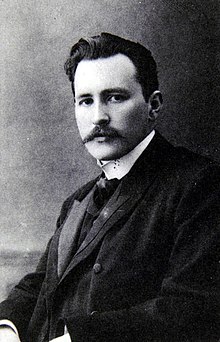Nikolai Vissarionovich Nekrasov
Nikolai Vissarionovich Nekrasov ( Russian Николай Виссарионович Некрасов ., Scientific transliteration Nikolai Nekrasov Vissarionovič ; born October 20 . Jul / 1. November 1879 greg. In Saint Petersburg , † 7. May 1940 in Moscow ) was a liberal Russian politician. In 1917 he was the last Russian governor general of Finland .
Early years
Nikolai Nekrasov was born into the family of a priest. He studied engineering and graduated in 1902. In 1904 he was appointed lecturer in technical drawing at the Technical Institute in Tomsk . In 1905 he became professor of statics and bridge construction there. In the same year Nekrasov went into politics. After the Russian Revolution of 1905, Nekrasov supported the "Cadet Party " (officially Конституционная Демократическая партия), which was founded in the same year and which devoted itself to liberal ideas.
Nekrasov was elected to the third State Duma in 1907 . First he belonged to the progress group, before he became involved in the Cadet Party after its dissolution and became one of its leaders. In the fourth State Duma he was elected second deputy chairman of parliament in 1916. In early 1916 he forged a cross-party coalition to force the tsar to abdicate while preserving the constitutional monarchy.
government
After the February Revolution of 1917, Nekrasov became Minister of Transport in the Provisional Government on March 2, 1917 . During this time he got closer and closer to Kerensky . Above all in the question of concessions to the autonomy of Ukraine , which the Cadet Party opposed, it finally came to a break between Nekrasov and his party. He resigned from the government on July 2nd. A few days later, on July 8th, he was once again entrusted with a government office as Deputy Prime Minister Kerensky. During Kerensky's absence, he chaired the government meetings. In mid-September 1917 he withdrew again from the government, as the attacks against him had become increasingly harsh.
Governor General
Nekrasov was then appointed governor general in Finland. He took up his post on September 17, 1917, but only held it a few weeks before the overthrow of November 7, 1917 marked the de facto end of the personal union between Russia and Finland. Nekrasov received the news in Petrograd on the morning of the same day. He then informed the Finnish Senate that he would not return to Finland. On December 6, 1917, Finland officially declared its full independence. Nekrasov was the last Russian governor general of Finland.
Russian civil war
During the Russian Civil War (1917 / 18-1920) Nekrasov withdrew from politics. In 1919 he moved to Kazan . He was arrested in March 1921, but released from prison two months later. He then became a board member of the Association of Consumer Cooperatives.
Order of the Red Banner of Labor (1938)
Arrests and death
On November 3, 1930, Nekrasov was arrested again and sentenced to ten years in prison on bogus charges. In March 1933, however, he was released. He was arrested again on June 13, 1939, sentenced to death and executed on May 7, 1940.
literature
- Nikolai Vissarionovich Nekrasov . In: Theodor Westrin, Ruben Gustafsson Berg, Eugen Fahlstedt (eds.): Nordisk familjebok konversationslexikon och realencyklopedi . 2nd Edition. tape 37 : Supplement: L – Riksdag . Nordisk familjeboks förlag, Stockholm 1925, Sp. 730 (Swedish, runeberg.org ).
- Aleksandr Nekrasov / Tat'jana Nekrasova: Nikolaj Nekrasov - failed statesman. The fate of a politician in the revolutionary era . In: Yearbook for Historical Research into Communism , 2017, pp. 185–200.
Web links
- Article Nikolai Wissarionowitsch Nekrasow in the Great Soviet Encyclopedia (BSE) , 3rd edition 1969–1978 (Russian)
- Biographies. Chronos (Russian)
| personal data | |
|---|---|
| SURNAME | Nekrasov, Nikolai Wissarionowitsch |
| ALTERNATIVE NAMES | Некрасов, Николай Виссарионович; Nekrasov, Nikolaj Vissarionovič |
| BRIEF DESCRIPTION | Russian politician |
| DATE OF BIRTH | November 1, 1879 |
| PLACE OF BIRTH | St. Petersburg |
| DATE OF DEATH | May 7, 1940 |
| Place of death | Moscow |
